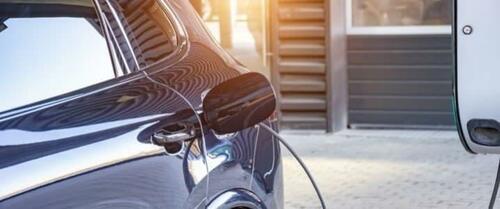Europe’s EV Boom Faces Grid Challenges
Authored by Tsvetana Paraskova via OilPrice.com,
-
Last week, the European Commission proposed an action plan to make sure “electricity grids will operate more efficiently and will be rolled out further and faster.”
-
Range anxiety has been one of the hurdles to a faster adoption of electric vehicles.
-
Toyota Europe’s chief operating officer Matt Harrison has recently said that Europe still needs work to do in charging infrastructure to reach the tipping point for significantly boosting the share of EVs.
Burdensome permitting processes and the need for extra grid connections and power capacity are slowing down the installation of EV charging stations across Europe, threatening the EU’s ambition to rely on transport electrification as a pillar of its net-zero target.
The EU adopted early this year legislation to make all new cars and vans registered in Europe zero-emission from 2035. The European Commission has also just proposed an action plan for grid investments across the bloc, aiming to upgrade grids, strengthen energy infrastructure, and allow faster access for renewables to the grids.
Despite the EU ambitions and the EU-wide legislation, local-level regulations and requirements to have a charging point hooked up to the grid sometimes takes years, and the delays have become longer in recent years, energy companies and industry associations tell Reuters.
“Although the work of installing a fast and ultra-fast charging point requires only two to three weeks of work, due to different administrative requirements in Spain, the complete process … can last from one to two years,” Spanish energy firm Repsol told Reuters.
The red tape in Germany, Europe’s largest car market, is similarly burdensome, industry sources say.
EU Plan to Upgrade Electricity Grids
Last week, the European Commission proposed an Action Plan to make sure “electricity grids will operate more efficiently and will be rolled out further and faster.”
A total of 40% of EU distribution grids are more than 40 years old. Cross-border transmission capacity is set to double by 2030, and this will need $633 billion (584 billion euros) in investments, the Commission said.
“Networks will have to accommodate a more digitalised, decentralised and flexible system with millions of rooftop solar panels, heat pumps and local energy communities sharing their resources, more offshore renewables coming online, more electric vehicles to charge, and growing hydrogen production needs,” the EC added.
Kadri Simson, the European Commissioner for Energy, said “Grids need to be an enabler, not a bottleneck in the clean energy transition. That way we can integrate the vast amounts of renewables, electric vehicles, heat pumps and electrolysers that are needed to decarbonise our economy.”
In response to the plan, renewable industry associations called for urgent actions.
“Serious action is needed asap to tackle the huge and growing queues of renewables that are waiting for a grid connection. The system operators in Europe need help here. Some of them have connection queues of hundreds of GW of wind and solar projects,” the WindEurope association said.
Rules for More Charging Stations
This summer, the European Parliament successfully negotiated that electric charging pools for cars with a minimum 400 kW output will have to be deployed at least every 60 kilometers (37 miles) along core TEN-T network routes by 2026, with the network’s power output increasing to 600 kW by 2028. For trucks and buses, charging stations have to be provided every 120 km (75 miles). These stations should be installed on half of main EU roads by 2028 and with a 1400kW to 2800 kW power output depending on the road. EU countries will also have to ensure that hydrogen refueling stations along the core TEN-T network will be deployed at least every 200 km (124 miles) by 2031.
Range anxiety has been one of the hurdles to a faster adoption of electric vehicles.
The EU now has the plans, but it’s up to individual member states to accelerate permitting, including for construction and access of charging stations to the grid.
“The time needed for connecting the EV recharging points to the grid can indeed be seen as a barrier to accelerate the uptake of EVs and needs to be tackled,” a spokesperson for the European Commission told Reuters in an email.
Municipalities are slow with permitting, while grid operators and power distributors don’t have uniform requirements for charging stations, which could delay the rollout, industry managers say.
“There is a clear need for more standardization,” Stefan van Dobschuetz, vice president of BP Pulse Europe, told Reuters.
BP Pulse, the EV charging business of BP, has an ambition to have more than 100,000 chargers installed worldwide by 2030 focused on ultra-fast charging.
ChargeUP, the industry association, has been calling for standardization and fast deployment of charging infrastructure across Europe.
The largest bottleneck charge point operators (CPOs) face across Europe today “is the amount of time it takes to establish a grid connection point, the complexity of the process to get one, and access to sufficient grid capacity,” the association says.
More than 20 CPOs across Europe have signed an open letter to propose five criteria benchmarking permitting processes that would harmonize and standardize the process of getting a grid connection in Europe.
Toyota Europe’s chief operating officer Matt Harrison has recently said that Europe still needs work to do in charging infrastructure to reach the tipping point for significantly boosting the share of EVs.
“The enablers are not really fully there yet, so I’m not surprised we’re having a bit of a wobble,” Harrison told Bloomberg in an interview this week.
“There are a lot of fundamentals that still need to be fixed before we start to move.”
Tyler Durden
Fri, 12/08/2023 – 03:30
via ZeroHedge News https://ift.tt/f37bVrU Tyler Durden
